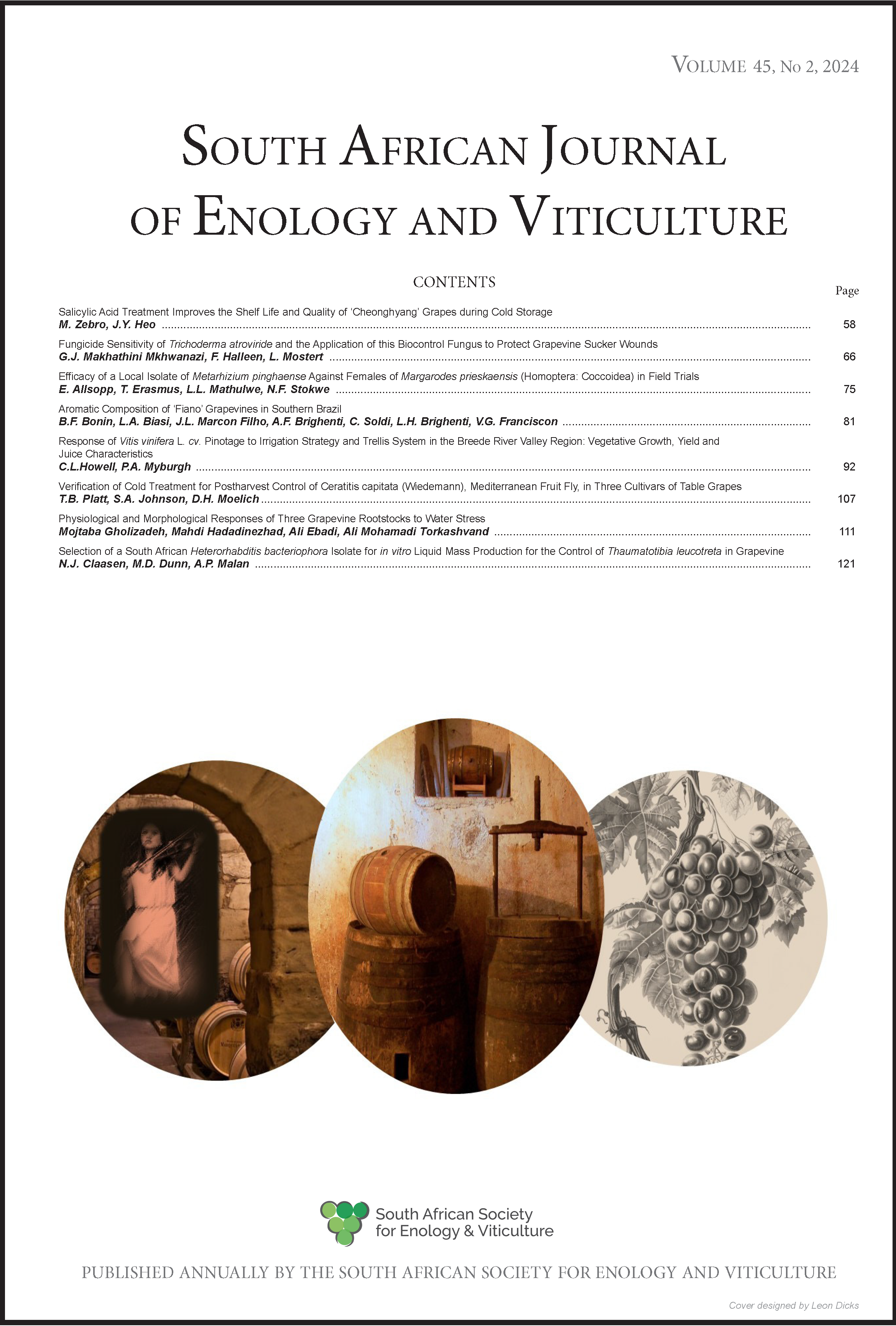Physiological and Morphological Responses of Three Grapevine Rootstocks to Water Stress
DOI:
https://doi.org/10.21548/45-2-5861Abstract
Water deficit stress is one of the most frequent environmental stresses affecting the physiological and growth responses of plants, especially grapevines. However, grapevine varieties and species differ in their tolerance to water stress. To identify the most tolerant grapevine rootstock, a factorial randomised block design with two factors was used. The first factor included the susceptible cv. Sultana (V. vinifera L.) scion grafted onto three rootstocks (Yaghouti, Kolahdari and 140 Ru), and the second factor was water stress potential at three levels (control, -1 MPa and -2 MPa). The physiological parameters, such as malondialdehyde (MDA), electrical leakage (EL), proline, soluble sugar, protein, photosynthetic pigments, and antioxidant enzymes were investigated. Our results revealed that increasing water stress enhanced H2O2, MDA, EL, proline, soluble sugar, and soluble protein, while decreasing chlorophyll (Chl) and carotenoid contents, growth parameters, and plant dry weight. The glutathione peroxidase (GPX) activity was enhanced in response to water deficiency, whereas catalase (CAT) and ascorbate peroxidase (APX) enzymes exhibited higher activity at -1 MPa, which was then reduced under the lowest water potential (-2 MPa). In addition, 140 Ru rootstocks exposed to water stress had lower levels of MDA, H2O2, EL, and higher Chl (a, b), carotenoid, APX, and GPX activity, as well as higher shoot dry weight. Overall, the physiological and morphological responses of the three rootstocks propose that grafting the commercial Sultana cultivar onto drought-tolerant rootstocks such as 140 Ru is an effective strategy for improving drought stress tolerance.
Downloads
Downloads
Published
Issue
Section
License
A copyright form will be e-mailed to the corresponding author when the manuscript has been accepted for publication.
In principle, the Author agrees to the following when he/she signes the copyright agreement:
I hereby assign to the SOUTH AFRICAN SOCIETY FOR ENOLOGY AND VITICULTURE (SASEV) the copyright of the text, tables, figures, supplementary material, illustrations and other information (the Material) submitted with the manuscript to be published in SOUTH AFRICAN JOURNAL OF ENOLOGY AND VITICULTURE (SAJEV) (the "Article"). The copyright becomes effective from the date the Article has been accepted for publication in SAJEV.
This is an open access journal, and the authors and journal should be properly acknowledged, when works are cited.
Author's may use the publishers version for teaching purposes, in books, theses, dissertations, conferences and conference papers.
A copy of the authors' publishers version may also be hosted on the following websites:
- Non-commercial personal webpage or blog.
- Institutional webpage.
- Authors Institutional Repository.
The following notice should accompany such a posting on the website: This is an electronic version of an article published in SAJEV, Volume XXX, number XXX, pages XXX - XXX, DOI. Authors should also supply a hyperlink to the original paper or indicate where the original paper (www.journals.ac.za/index.php/sajev/) may be found.
Authors publishers version, affiliated with the Stellenbosch University will be automatically deposited in the University's Institutional Repository SUNScholar.
Articles as a whole, may not be re-published with another journal.
The following license applies:
Attribution CC BY-NC-ND 4.0

